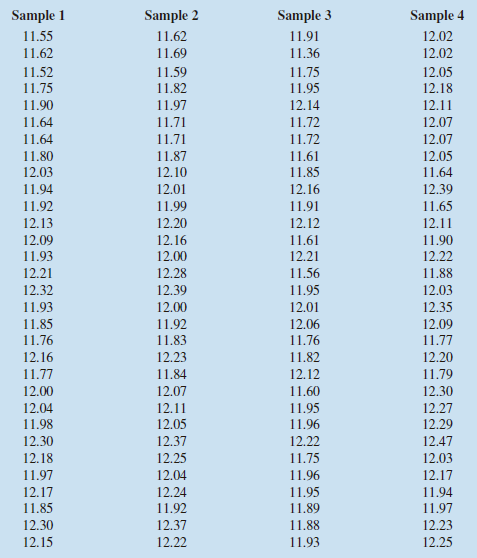Quality Associates, Inc., a consulting firm, advises its clients about sampling and statistical procedures that can be
Question:
Quality Associates, Inc., a consulting firm, advises its clients about sampling and statistical procedures that can be used to control their manufacturing processes. In one particular application, a client gave Quality Associates a sample of 800 observations taken during a time in which that client’s process was operating satisfactorily. The sample standard deviation for these data was .21; hence, with so much data, the population standard deviation was assumed to be .21. Quality Associates then suggested that random samples of size 30 be taken periodically to monitor the process on an ongoing basis. By analyzing the new samples, the client could quickly learn whether the process was operating satisfactorily. When the process was not operating satisfactorily, corrective action could be taken to eliminate the problem. The design specification indicated the mean for the process should be 12. The hypothesis test suggested by Quality Associates follows.
H0: µ = 12
Ha: µ ≠ 12
Corrective action will be taken any time H0 is rejected.
The samples on the following page were collected at hourly intervals during the first day of operation of the new statistical process control procedure. These data are available in the DATAfile named Quality.
Managerial Report
1. Conduct a hypothesis test for each sample at the .01 level of significance and determine what action, if any, should be taken. Provide the test statistic and p-value for each test.
2. Compute the standard deviation for each of the four samples. Does the assumption of .21 for the population standard deviation appear reasonable?
3. Compute limits for the sample mean x around ‑ 5 12 such that, as long as a new sample mean is within those limits, the process will be considered to be operating satisfactorily. If x exceeds the upper limit or if x is below the lower limit, corrective action will be taken. These limits are referred to as upper and lower control limits for quality control purposes.
4. Discuss the implications of changing the level of significance to a larger value. What mistake or error could increase if the level of significance is increased?

Step by Step Answer:

Modern Business Statistics With Microsoft Excel
ISBN: 9781337115186
6th Edition
Authors: David R. Anderson, Dennis J. Sweeney, Thomas A. Williams, Jeffrey D. Camm, James J. Cochran





